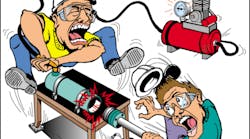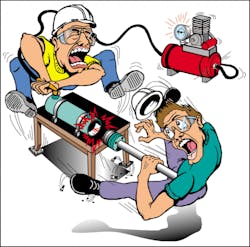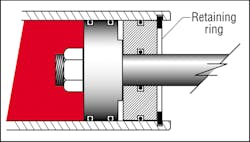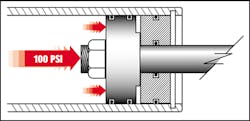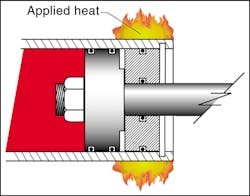Scenario: Mike, a maintenance supervisor and Walt, a maintenance mechanic, were severely injured as a result of an accident they caused while disassembling a large hydraulic cylinder. The accident occurred while they were trying to remove the rod/gland assembly from the cylinder. In their attempt to remove the assembly, they first pressurized the cylinder with approximately 100 psi compressed air with the objective of pushing the gland out. The attempt failed.
Then they figured that if —in addition to applying force with compressed air —they heated the cylinder barrel in the vicinity of the gland assembly, the cylinder tube would expand, and possibly release its grip on the gland assembly.
They used an acetylene torch with a rosebud tip to apply heat to the surface of the cylinder tube. Within minutes, the gland assembly unexpectedly blew out with a deafening explosion that was heard throughout the complex, Figure 1.
The ambient air collected the residual oil in the cylinder as it rapidly de-compressed. The air/oil mixture ignited into a fiery inferno when it contacted the torch’s open flame. Both men were knocked to the ground by the forces of the giant explosion. They were both covered in hydraulic oil as it sprayed out of the open end of the cylinder tube —and both were quickly engulfed in flames.
A passer-by grabbed a nearby fire extinguisher and doused the flames. The heavy gland assembly had ripped Mike’s leg off as the compressed air blasted it out of the cylinder. He also suffered extensive burns. Walt suffered extensive burns and a broken leg.
Events that led to the accident
Walt was carrying out a routine service on a large hydraulic cylinder that included an inspection of the internal wear rings. He noted that there was some external leakage from the rod/gland seals. The cylinder design was typical of those found in mobile hydraulic applications. This design usually has a gland assembly recessed inside the open end of the rod end cap. The assembly is secured with a metal retaining ring that fits into a groove machined around the ID of the cylinder tube, Figure 2.
After removing the retaining ring, he tried in vain to extricate the rod/gland assembly manually. All indications were that it was seized. In his next attempt, he tried to pull the rod/gland out by attaching it, via a cable, to a forklift truck. This also failed to move the gland assembly.
Walt discussed the problem with Mike, his maintenance supervisor, and together they decided to try to push the stubborn gland assembly out with compressed air, Figure. 3. They went so far as to calculate the force that 100 psi would generate against the gland area.
They installed a quick-disconnect fitting to the port at the cap of the cylinder. Then, they connected the air-supply hose from the compressor to the cylinder port, and pressurized the cylinder with the air. They observed the pressure on the air compressor’s pressure gage. The compressed air, and resultant force, failed to push the gland assembly out as they had planned.
After further discussion, Walt and Mike decided that the cylinder tube’s grasp on the gland assembly might be relinquished by using heat to expand the cylinder tube in the vicinity of the gland, Figure 4. Using an acetylene torch with a special tip for heating. Mike applied heat to the cylinder tube, distributing the heat uniformly around the outside diameter of the tube. After approximately three to five minutes, the explosion occurred.
A common occurrence?
Unfortunately, the results of an industry-wide survey of heavy-duty mechanics yielded discouraging results —over 90% of the heavy-duty mechanics we spoke to have either used compressed air to extricate a rod/gland assembly or know someone who has.
This shows that not only is this a common practice, but also one that is regarded as acceptable. Even companies with the most rigorous safety programs may overlook this critical safety issue. Many of the people with whom we spoke about this practice, responded anecdotally about having blasted a cylinder rod assembly through a door or a wall.
How this accident could have been prevented
Training —there is no tool that is more effective at reducing or eliminating work-related accidents than training. Training empowers people to make safety-based decisions. This accident would not have occurred had the victims received proper training on how to disassemble a hydraulic cylinder.
This is a simple, straightforward procedure for a properly trained person. Oftentimes, it is assumed that mechanics can figure out disassembly and assembly procedures. These are times when written instructions are vital.
All hydraulic accidents must be investigated —Hydraulic accidents occur on a daily basis in plants and factories around the world. Unfortunately, in most cases, only those in which a person is injured or killed are investigated.
For example, a hydraulic hose-end failure is an accident. However, less than 1% of the hose-end failures that occur are ever investigated to determine the root-cause of the failure.
Follow service and repair instructions —Component and machinery manufacturers must provide clear, safety-based, accurate information that is user-friendly. The information must apply to their machinery. For example, a manufacturer might use a particular brand of pump in a machine. The information about the pump is usually a photocopy of the pump manufacturer’s generic information. However, the information might not apply directly to that entire machine.
A manufacturer must state very clearly if specialized tools are needed for a particular task, and make those tools available. If specialized skills are needed to do the job, they must be stated.
Competent technical assistance —Component and machinery manufacturers must have properly trained personnel to cater to customers╒needs. The advice people are given must be safety-based and accurate.
Proper tools — There are certain tools that are needed for almost any job. A hydraulic technician should have flow meters, pressure gages, temperature gages, and any other special tools required to service and repair hydraulics.
How to safely remove a stubborn rod or gland
1. Wear safety glasses.
2. Place the cylinder on a suitable table and secure it with the ports in the vertical position.
3. Remove the locking device from the rod/gland assembly (refer to cylinder manufacturer’s information for guidance).
4. Pull the rod out (if possible) all the way, until it stops against the end of the cylinder.
5. Place a suitable support under the rod to prevent it from falling and causing possible injuries. The support will also prevent the rod from getting damaged, when it comes out.
6. Place a suitable receptacle under the cylinder (rod/gland area) to catch the oil when the rod/gland comes out.
7. Pluse the ort in the rod end of the cylidner with a suitable plug that has the proper pressure rating.
8. Tilt the closed-end of the cylinder upwards slightly and place suitable spacer (approximately 1 in.) under it.
9. Fill the cylinder (through the closed-end port) with hydraulic oil.
10. Connect a 300-psi mechanical hand-pump with pressure gauge to the closed-end port.
11. Gradually pump the hand pump while observing the pressure gauge. The rod/gland assembly should begin to move. Keep on pumping until the rod/gland is pushed completely out of the cylinder tube.
12. If the rod/gland assembly does not move the time the pressure reaches the maximum pressure rating of the cylinder, suspend pumping and release the pressure.
13. Call the cylinder manufacturer for guidance.
Warning - do not continue gland removal using trial-and-error methods.
Note: this procedure is recommended for occasional cylinder service and repair only. For high-volume cylinder service and repair, we recommend that you consider acquiring a proper cylinder-service repair bench.
Rory McLaren is president, Fluid Power Training Institute, Salt Lake City. For more information, call (801) 908-5456, email [email protected], or visit www.fpti.org.
Caution: Rory McLaren and the Fluid Power Training Institute do everything possible to ensure that the information and drawings contained in these reports are accurate and that the suggested procedures are deemed safe and reliable. However, these are general recommendations only and might not be applicable to all situations. You must have your engineering and service departments read these recommendations and make the necessary changes for your specific conditions.The Fluid Power Training Institute is not responsible for actions taken by untrained or unauthorized persons. All hydraulic system service, repair, and troubleshooting should be conducted only by trained, authorized personnel.